What happened during the IRA ambush at Kingsmills?
- Published

The textile workers were travelling home from work when their minibus was ambushed
On 5 January 1976, a mini-bus carrying textile factory workers was ambushed by an IRA gang near the County Armagh village of Kingsmills.
The men were travelling home when their bus was stopped by a man standing in the road flashing a torch.
As the bus came to a halt, 11 other men, all masked and armed, emerged from hedges around the road.
The IRA men ordered the passengers out of the bus demanding to know the religion of each of the men.
One of the workers, who identified himself as a Catholic, was told to leave.
The gang then opened fire on the remaining passengers, killing 10 Protestant workmen and seriously wounding another.
Alan Black, who was 32 at the time, would spend months in hospital recovering from his injuries.

The victims of the Kingsmills massacre
Who were the Kingsmills victims?
The 10 men who were killed at Kingsmills were:
John Bryans
Robert Chambers
Walter Chapman
Robert Freeburn
Reginald Chapman
Joseph Lemmon
John McConville
James McWhirter
Robert Walker
Kenneth Worton
A memorial service is held in south Armagh every year to remember them.

Alan Black survived the attack
Alan Black was shot 18 times during the attack.
Years later he recalled lying beneath the body of one of his colleagues, pretending to be dead.
"At that time I was convinced I was going to die," he told the BBC.
Mr Black also recalled how Robert Chambers, who was a teenager and Mr Black's apprentice, was crying out for his mother at the moment a gunman shot him in the face.
He added Robert Chambers was "a lovely lad" who was much loved by his family.
In 2020, Mr Black was appointed MBE for services to the community in south Armagh.
Who carried out the Kingsmills shootings?
No-one has been convicted of the attack.
The IRA never admitted involvement and was supposed to be on ceasefire at the time.
The name South Armagh Republican Action Force was used to claim the murders.
However, a report published in 2011 by the Historical Enquiries Team (HET) found that the IRA was responsible for the atrocity and that the victims were targeted because of their religion.
Inquest
In 2013, the attorney general ordered the coroner to launch an new inquest into the massacre.
Three years later, shortly after the inquest began hearing evidence, it was suspended following a forensic breakthrough by police.
Officers believed a palm print found on a vehicle used during the killings belonged to a suspect arrested earlier that year.
However, no prosecutions resulted from this evidence and the inquest resumed its work.
A senior police officer told the hearings there were informational and evidential gaps linking the suspect to the murder, and there may have been an "innocent explanation" for the presence of the handprint on the van.
The inquest has heard from witnesses to the massacre, as well as former police and counter intelligence officers.
It has been beset with delays and adjournments, and at times has been subject to protest by the families of those killed in the attack for the length of time it has taken to reach its conclusions.
The families of the victims also walked out of the proceedings in 2020 over a refusal to name two IRA men suspected of involvement in the murders.
It was not until March 2023 that the inquest heard its final submissions during a sitting at Dungannon Courthouse, a decade after the investigation was first ordered and nearly 50 years after the attack.
Related topics
- Published26 February 2020

- Published12 April 2024

- Published5 September 2018

- Published15 May 2017

- Published16 June 2011
